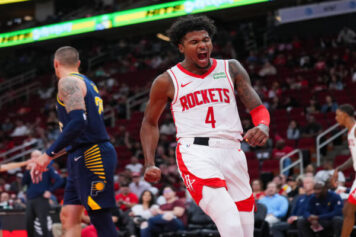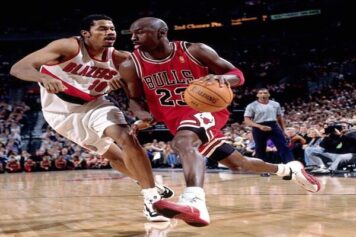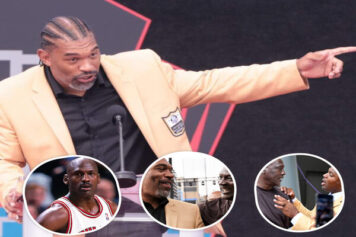How many times have you slowed down a clip of Hakeem Olajuwon and shook your head at the craziness of the move you just saw? He would go right, left, up, under, embarrass you (sometimes with a chuckle) with a ball fake and then do something so sick the ball was even respectful by gracing the net ever so softly with "class". It was as if Dream studied the game and created an alternate hoops universe where his signature move was actually the norm.
That’s how great he perfected it. The “Dream Shake” was as potent as Kareem Abdul-Jabbar’s skyhook, Kevin McHales’ up- and-under, Spencer Haywood’s turn-a-round jumper or anything Julius Erving executed on the break. It was so efficient and pretty, the player or players defending rarely were able to touch Dream let alone foul him.
Soccer in his native Nigeria gave him his stellar footwork and because he was so incredible on the block, instead of embarrassment, players Dream shook out their socks should actually feel honored. They didn’t know what he was going to do, so how could anyone clown them? At 6-foot-10, he could palm the ball high so guards sneaking to double pre or post bounce couldn’t strip him. Then he'd spin baseline and pop a sweet 15-footer, spin to the middle and hit a robotic foul line-jumper or render the opposition clumsy in all kinds of ways down low. He credits Hall of Fame center Moses Malone for teaching him the game from a toughness standpoint to not only get him ready for his sophomore season at the University of Houston, but also the NBA. Think of how Moses got his baskets; he was relentless until the rock fell through the twine. So was Dream and because Coach Ganiyu in Nigeria told him to put down the soccer ball and pick up the rock, he became a basketball icon. We talk about Kareem’s skyhook being unstoppable, but how many players have adopted his signature shot? With that in mind, think about how many players of every position emulate the Dream Shake.
His first name was on the back of his college jersey, not his last. Phi-Slamma-Jamma of ’82-‘84 rocked college hoops with a style of play the inner-city and basketball at-large adored. The Houston Cougars, along with Georgetown Hoyas, were that first team the hood identified with and blazed a path for teams like UNLV and Michigan.
Anyone watching the University of Houston knew this was a special team led by Dream and Clyde Drexler and also by a special coach in Guy Lewis (think Elvin Hayes vs. UCLA). Houston made the Final Four Dream’s redshirt freshman season and lost in the National Final his sophomore and junior seasons. They lost in an all-time shocker to Jim Valvano and NC State in ’83 and just didn’t have enough for Coach John Thompson and Patrick Ewing in ’84. Dream was so good in ’83 he won NCAA Tournament Player of the Year despite losing to the Wolfpack. What if he would have grabbed Dereck Whittenburg's air ball instead of Lorenzo Charles? That moment became Jim Valvano's for history and it was certainly fitting for the late great head coach. Drexler and Dream would finally win an NBA title together in 1995 with the Houston Rockets. Dream was a first team All-American in 1984 along with Michael Jordan, Patrick Ewing, Sam Perkins and the late Wayman Tisdale.
Olajuwon became more than Phi-Slamma-Jamma and is the only man alive that could honestly say he and his Rockets mates could have beaten Michael Jordan in the NBA Finals (Houston 12-9 vs. Chicago in that era). Two rings in dominate fashion when Mike was on a Boys of Summer sabbatical say I tell no lies, and in ’94, he won without the benefit of another Hall of Fame player. Who has done that? Dream was the cat I wanted to see face Wilt Chamberlain and honestly, Mike might not be considered the greatest if Ralph Sampson hadn’t hurt his back. In fact, Michael Jordan says Dream is his top all-time center. No one was better all-around and like Mike says, Dream was in the top 10 NBA all-time in five categories: steals, rebounds, scoring, blocks and shooting percentage. How many Hall of Fame centers did he dominate? Count them off: David Robinson, the aforementioned Abdul-Jabbar, Shaquille O’Neal, Robert Parrish, Patrick Ewing. Yes, McHale even got some trying to check Dream from the 4 spot.
Hakeem Olajuwon was drafted ahead of Michael Jordan and very few are critical of the Houston Rockets for that decision. After his success, anyone with ties to basketball and access to Africa ran for the continent and searched for the next teenage Dream.
Now Africans are everywhere in hoops and many other sports. Dream did that. For 18 years he was an African wonder dominating an American sports world despite learning the game late. His parents Salim and Abike — who owned a cement business — raised him right, because Dream was businesslike and professional. Rarely did the opposition bring it to his face with bass. He was just too much of a respected athlete to disrespect publicly or privately. On the court, he would kill dudes on Ramadan as if he had just indulged in the greatest of feasts. That was so incredible about Dream. He had this self-discipline that kept him on an even plane mentally and physically every time you saw him play or heard him talk. Dream was the first superstar in an era of huge money that didn’t seek endorsement deals and is famous for selling a $35 dollar kick when others sold for at least $100. He was humble and just wasn’t interested in exploiting his talent or his fans in any way. Dream came along in a center-rich era and became his own name without self-promotion. That’s no diss to anyone who puts their name out there because it simply shows how great Hakeem Olajuwon really was. Word to Phi-Slamma-Jamma.



